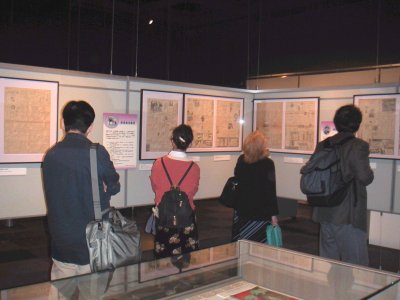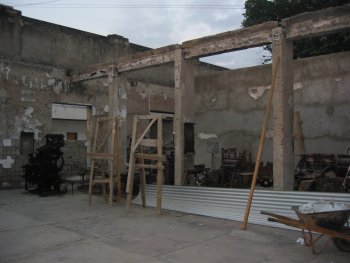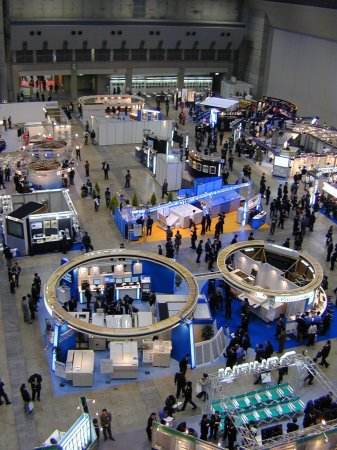|
The registration form
NSK News Bulletin Online
December 2003 -------------------------------------------------------------------
*Topics --NEWSPARK Features Exhibition of Newspaper Comics --Interview with the Publisher/Editor of "The Voice of East Timor" - - - - - - - - - - - - - - - - - - - - - - - - - - - - - - - - - - - - - - Story of the Month>>> 20,000 Visit Newspaper Production Show -------------------------------------------------------------------
The Nihon Shinbun Kyokai (NSK) on Dec. 10 issued its official response to the "EU Priority Proposals" calling for the abolition of the Japanese kisha club system. The response was based on a position paper drafted by the press club issues subcommittee of the NSK Editorial Affairs Committee. NSK said that the kisha club system functions effectively as an institution that ensures the people's right to know and concluded that there is absolutely no need to abolish it. That comment came in response to the call for the abolition of the system made by the Delegation of the European Commission in Japan. The delegation made the call on Nov. 14 at an EU-Japan High-Level Meeting on Regulatory Reform. The EU had made the same demand a year ago. After the EU delegation called for the abolition of the system in October of last year, the NSK Editorial Affairs Committee reactivated its subcommittee on press club issues to complete a review of the kisha club system. The NSK statement on the matter was a product of the review. NSK said: 1) The kisha club system has for more than 100 years pushed for the release of information by parliament, the public administration and other public institutions, all of which remain reluctant to disclose information; and 2) the kisha clubs have worked to provide swift and accurate reporting of public information, have organized newsgathering and reporting activities on human life and human rights issues, and have served to provide information as a common window for citizens. The EU had said the system encourages overdependence on a single source of information and discourages crosschecking, thus diminishing the quality of information available to the wider public. NSK rejected that argument as "utterly groundless" and "invalid". It said that instead, doing away with the kisha clubs would constitute an abandonment of media responsibility, undermining the quality of information available to society. In response to an EU call for all holders of the Ministry of Foreign Affairs press card to be allowed to attend media events organized by official bodies on an equal footing with domestic journalists, NSK reiterated its past stance that: 1) Journalists from foreign media organizations should generally be granted regular membership in press clubs, if they desire to join; and 2) It is inappropriate to limit attendance at official press conferences only to members of press clubs. In view of NSK's stand, many press clubs are opening the door to foreign media organizations, and press conferences organized by press clubs are open to non-members. NSK cited these facts in rebutting as one-sided the foreign media organizations' complaints about "exclusivity" and "restrictions". In response to the EU argument that access to official press conferences, briefings and other media events is generally restricted to members of the corresponding kisha club, NSK said: "Briefings and off-the-record briefings, whatever they may be called, are forms of newsgathering that should essentially be conducted individually by each media organization or journalist, but are organized collectively at the convenience of the briefing party. This form of newsgathering is something that Japan's journalists have won by collectively pressuring public institutions, which tend to hide information from the public. Such events, even if regular, depend on a degree of trust between the briefing party and the journalists. Accordingly, such briefings cannot be open to every journalist. It is up to the briefing party to decide who can attend." In conclusion, NSK said, "Each country has its own institutions and historical rules for newsgathering. The Japanese kisha club system grew out of the nation's history. The EU demands reflect a lack of understanding of the background and must be seen as being based on misunderstanding, prejudice and factual error."
In response to the NSK comment, the delegation of the European Commission in Japan issued a statement the next day, Dec. 11, applauding Japan's pledge to open the kisha club system to the foreign media. But the EU denied that it suffered from any misunderstanding, cultural prejudice or factual errors. Etienne Reuter, the chief of the EU delegation's press, public and cultural affairs section, said the EU is not aiming at abolishing the kisha clubs, but instead said it hoped only to change the way that kisha clubs exclude foreign journalists from getting access to news sources. Reuter said that foreign journalists are trying to report what is happening in Japan mainly in economic terms. However, the EU has included the kisha clubs among proposals for regulatory reform to the Japanese government, arguing that they constitute an impediment to trade -- in information. Reuter said the fundamental issue goes beyond a trade matter, pointing to discriminatory treatment of journalists from weekly and monthly magazines. He said that the quality of the press and the quality of journalists' work are also affected. He warned that the public desire to get the news will falter if all news is only presented as if it had been controlled and spoon-fed to journalists. He said that whether foreign journalists get fair access to Japanese news sources should be seen as a major factor in Japan's image in the rest of the world. He also said that the issue will directly affect Europeans who are considering whether to invest in Japan or even to visit Japan as tourists.
The Yomiuri Shimbun began partial operations at its new factory in Kita Ward, Tokyo, with its morning issue of Nov. 9. The factory will go into full operation in January, printing about 1 million morning edition copies and 450,000 evening edition copies for delivery to northern parts of Tokyo and southern parts of Saitama Prefecture. It will replace some printing functions that had been handled at the company's Tokyo head office. The new factory is the Yomiuri group's 27th domestic printing facility, and is the largest in the Tokyo metropolitan area, matching the capacity of its Kawagoe factory in Saitama Prefecture. The new factory is operated by a wholly owned Yomiuri subsidiary. The building is four stories high and has a basement floor that brings its total floor space to 21,158 square meters. Like the Yomiuri's Koto and Shiohama factories, the new facility uses the computer-to-plate (CTP) system to support a set of six fast-speed tower-type shaftless presses (CT-7000CD) capable of producing 170,000 copies per hour of a 40-page newspaper with 16 color pages. The Yomiuri, which is to mark its 130th anniversary of publication next fall, has been stepping up preparations to build the infrastructure to deliver a 40-page newspaper with 16 color pages. The company sees the new factory as an important printing base easing the load on its factory at its Tokyo head office. The number of copies to be printed at the head office is to fall to just under 300,000 morning edition copies. The new factory flanks the Horifune Warehouse of Nippon Paper Industries Co. and the Nikkan Sports Printing Co.'s Oji factory. Underground tunnels between the warehouse and the two factories are to be used to move newsprint paper to the factories over conveyor belts. The three companies are working together to protect the local environment and co-exist with the community. A large vacant ground area is being preserved to the south of the factories, and to the north there is an avenue lined with cherry trees. By the fall of next year, a pedestrian lane about 900 meters around will be completed. The roofs of the two factories are streamlined to maintain natural wind flows. In addition, the Yomiuri is providing local residents a meeting hall and playground, while the Nikkan Sports will do the same with a meeting hall and another playground. Both companies are to use low-pollution newspaper delivery trucks that more than satisfy the Tokyo Metropolitan Government's new environmental-assessment standards. The three companies maintain a combined stockpile of 290 tons of water to use against any fire outbreak, with 40 tons of the water assigned for non-commercial uses and 10 tons of water available for drinking. The Yomiuri has offered a part of its factory compound as a site for the relocation of a warehouse of fire-fighting equipment for use by local volunteer firemen. In appreciation of these efforts, all three companies received commendations from the Oji Fire Station on Nov. 13.
|
||||||||||||||


 The 17th Japan Newspaper Production Show (JANPS 2003) was held for four days starting on Nov. 14 at the Tokyo International Exhibition Center --commonly known as Tokyo Big Sight. The biannual event was sponsored by NSK in cooperation with manufacturers from the Conference for Japan Newspaper Production Technique-Japan (CONPT). Just over 20,000 visitors from across Japan attended the show. The theme was, "Technologies and Creation Ushering In the Future: Environmentally Friendly Newspaper Production."
The 17th Japan Newspaper Production Show (JANPS 2003) was held for four days starting on Nov. 14 at the Tokyo International Exhibition Center --commonly known as Tokyo Big Sight. The biannual event was sponsored by NSK in cooperation with manufacturers from the Conference for Japan Newspaper Production Technique-Japan (CONPT). Just over 20,000 visitors from across Japan attended the show. The theme was, "Technologies and Creation Ushering In the Future: Environmentally Friendly Newspaper Production."